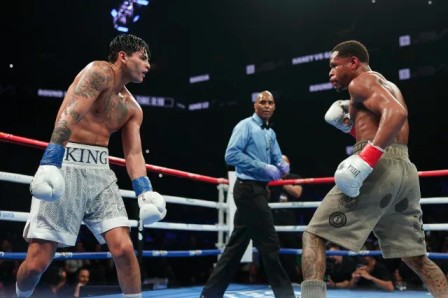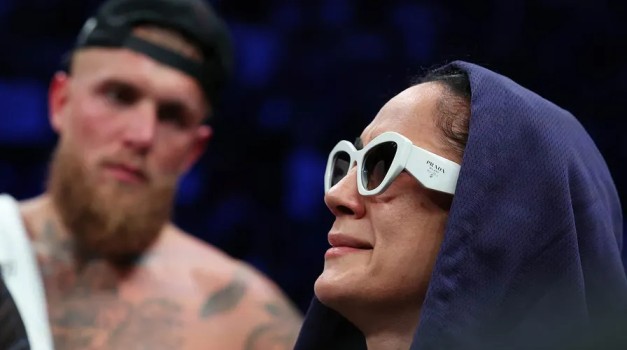
Key Takeaways:
- Ryan Garcia’s defense highlights the complex dynamics between fighters, promoters, and influential figures in boxing.
- The concept of “runners” in boxing is a contentious issue, sparking debate about strategic career management versus avoiding tough fights.
- Turki Alalshikh’s warnings underscore a push for more compelling and frequent top-tier matchups in the sport.
The world of boxing is rarely short on drama, both inside and outside the ring. Recently, a notable exchange has captured headlines, involving powerhouse promoter Turki Alalshikh’s stern warning to what he termed “runners” – fighters seemingly avoiding challenging matchups. This warning, intended to push the sport’s top talents into more frequent and exciting contests, drew a swift and unexpected reaction: a spirited Ryan Garcia defense of two of boxing’s most talked-about names, Shakur Stevenson and Devin Haney.
Ryan Garcia’s defense in this context is significant, not just for the individuals involved, but for what it reveals about fighter autonomy and the pressures within professional boxing. Garcia, known for his outspoken nature, took to social media to voice his perspective, effectively countering the narrative that Stevenson and Haney are deliberately evading formidable opponents. This bold stance has ignited further discussion, prompting fans and pundits alike to analyze the true implications of Alalshikh’s words and Garcia’s subsequent support.
The “Runners” Warning: A Call for Action or Unfair Pressure?
Turki Alalshikh’s pronouncements carry considerable weight in the boxing world. As a key figure in major events and a significant investor, his desire for premium matchups is understandable. His “runners” label is a clear attempt to encourage fighters to step up and face the best, aiming to deliver the highly anticipated bouts that fans crave. This perspective suggests that avoiding tough fights diminishes the sport’s integrity and excitement.
However, the concept of “running” is often debated. From a fighter’s perspective, career management involves strategic decisions. This can include waiting for the right financial offer, allowing time for physical recovery, or even building a larger profile before taking on a high-risk, high-reward encounter. The line between strategic planning and genuine avoidance can be blurry, and it’s a line that Ryan Garcia’s defense seeks to clarify.
Ryan Garcia’s Defense: A Champion for Strategic Career Paths
Garcia’s intervention suggests a nuanced understanding of a fighter’s journey. He seemingly argues that the term “runner” oversimplifies the complex choices athletes make. For Shakur Stevenson, known for his exceptional defensive skills and technical prowess, building a legacy means facing opponents on his terms. Similarly, Devin Haney, a unified lightweight champion, has navigated a challenging career path, consistently taking on high-caliber adversaries. [“strategic career management in boxing”]
Garcia’s defense resonates with many who believe that fighters should have the agency to dictate their careers, rather than being solely driven by external pressures or narratives. He implies that accusations of “running” can be unfair and fail to acknowledge the intricate negotiations, training camps, and personal sacrifices involved in professional boxing.
Implications for Boxing’s Future
This public exchange between Alalshikh and Garcia, with Stevenson and Haney at its center, highlights a fascinating tension in modern boxing. On one hand, there’s a push for more frequent blockbuster fights, driven by promoters and powerful figures. On the other, fighters are increasingly aware of their worth and the need to make astute career decisions.
The outcome of this dialogue could influence how future fights are negotiated and how fighters are perceived. Will Alalshikh’s warnings lead to an immediate surge in top-tier matchups, or will Garcia’s defense empower fighters to continue prioritizing their long-term career goals?
For fans, the ultimate desire is to see the best fight the best. This ongoing discussion, however, adds another layer of intrigue to the sport, revealing the battles that take place not just in the ring, but also in the realm of public opinion and strategic positioning. [“ BBC Sports“]
The Balancing Act: Fan Expectations vs. Fighter Reality
The pressure on fighters to perform and entertain is immense. Fans often demand immediate gratification, wanting to see the biggest names clash without delay. However, the reality for professional boxers involves managing their health, securing optimal financial terms, and strategically building their records. This table illustrates some key considerations:
| Aspect | Fan Expectation | Fighter Reality |
|---|---|---|
| Fight Frequency | More frequent, high-profile bouts | Careful scheduling, recovery time, opponent selection |
| Opponent Selection | Always fight the “best” available | Strategic matchups, financial incentives, risk assessment |
| Career Longevity | Sustained peak performance | Prioritizing health, avoiding unnecessary damage |
| Negotiations | Quick agreements for big fights | Complex discussions, multiple parties, detailed contracts |
This inherent tension is what makes Ryan Garcia’s defense so pertinent. He’s not just defending two individuals; he’s advocating for a more comprehensive understanding of a fighter’s professional life. [“Shakur Stevenson and Devin Haney“]
Suggested Call to Action (CTA): What are your thoughts on Ryan Garcia’s bold defense? Do you believe fighters should always prioritize immediate mega-fights, or is strategic career management a legitimate approach? Share your perspective in the comments below!
FAQs
1. Why did Turki Alalshikh issue a warning to “runners” in boxing?
Turki Alalshikh, a prominent figure in boxing, issued a warning to “runners” to encourage top fighters to face each other more frequently and avoid delaying major matchups, aiming to enhance the sport’s excitement and competitive integrity.
2. What was Ryan Garcia’s main argument in his defense of Shakur Stevenson and Devin Haney?
Ryan Garcia’s defense primarily centered on the idea that fighters have a right to manage their careers strategically, emphasizing that “running” might sometimes be a calculated move rather than an act of cowardice, and that external pressure shouldn’t dictate every career decision.
3. How might Turki Alalshikh’s warning impact future boxing negotiations?
Alalshikh’s warning could potentially accelerate negotiations for highly anticipated fights, as fighters and their teams might feel increased pressure to avoid being labeled as “runners,” possibly leading to more compelling matchups.
4. Have Shakur Stevenson and Devin Haney responded publicly to Ryan Garcia’s defense?
While Ryan Garcia’s defense has garnered attention, the public responses from Shakur Stevenson and Devin Haney regarding Garcia’s specific comments would need to be checked against current news sources.
5. What are the broader implications of this exchange for fighter autonomy in boxing?
This exchange highlights the ongoing tension between promoter/influencer demands and fighter autonomy. It raises questions about how much control fighters truly have over their careers versus the influence of powerful figures in the sport.






